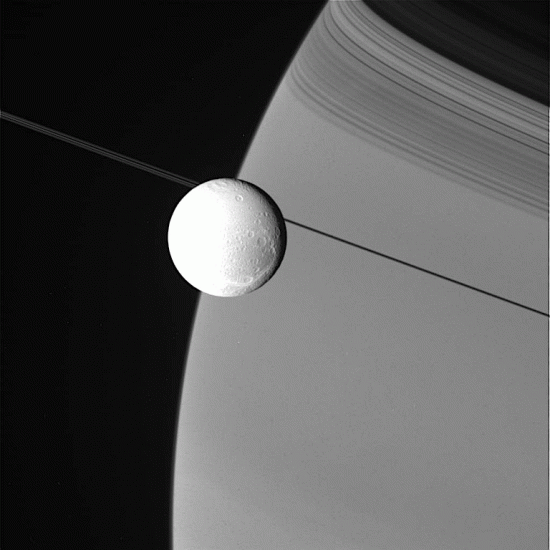Oct 03, 2013
Dione exhibits some unusual features that may indicate electrical forces at work.
Recently, the Cassini-Solstice spacecraft made a close flyby of the moon Enceladus. As the Picture of the Day from May 3, 2012 discussed, the bright plumes emanating from the 500 kilometer moon are most likely the result of an electrical connection between it and the gas giant planet Saturn. On the same day, Cassini also flew fairly close to Dione, another of Saturn’s enigmatic moons.
The formerly named Cassini-Huygens mission was launched from Cape Canaveral on October 15, 1997. Few now remember the public outcry against the mission. There were several attempts by citizens groups to stop the launch because of the 33 kilograms of plutonium-238 that provides electrical power to the orbiter. Since there had been failures of other launch vehicles, the concern was that an explosion of the Titan IV-B rocket would scatter radiation over many hundreds of square kilometers in southern Florida.
However, the launch was uneventful, and after several years flight time Cassini entered orbit around Saturn on July 1, 2004. A few months later, Cassini deployed the Huygens lander, which descended by parachute to the surface of the Solar System’s largest moon, Titan.
In the last eight years, Cassini has made close approaches to a number of Saturn’s moons, Dione among them. This time, the spacecraft looked at Dione from a distance of about 8000 kilometers, but it has come as close as 67 kilometers on previous passes.
Dione’s mean diameter is 1123 kilometers. In comparison, the diameter of Earth’s Moon is 3475 kilometers, so Dione is among the medium-large moons in the Solar System. Iapetus, Rhea, and Tethys are similar in size, as are Uranus’ moons Ariel, Titania, and Oberon.
The first images of Dione revealed a moon whose surface appeared to be dominated by bright “wisps” that wound around its face. Later, when higher resolution pictures were decoded, the wisps were discovered to be deep chasms and trenches that split large craters, running for hundreds of kilometers. Mission specialists remain baffled by the extent to which the moon has been “fractured”, although some form of faulting due to tectonic activity continues as their best guess.
According to a March 2, 2012 press release, ionized oxygen molecules have been detected on Dione. This means that Dione joins Saturn’s moon Rhea in possessing a highly rarified atmosphere. Planetary scientists speculate that the oxygen comes from solar wind ions impacting the water ice on both moons, causing it to crack into hydrogen and ionized oxygen.
Dione also joins its sisters Tethys and Enceladus in spewing charged particles into the ring structure around Saturn. Like Enceladus, the “plumes” are ejected from numerous hot spots. Evidence exists that Dione also contributes to the plasma trapped within Saturn’s magnetosphere. Jim Burch of the Southwest Research Institute used data from Cassini’s Plasma Spectrometer (CAPS) to determine that the plasma electrons were emitted from Tethys and Dione.
In the Electric Universe hypothesis, the charged particles from Dione (and Tethys) are due to plasma discharges that are ejecting material into space, in the same way that Jupiter’s moon Io contributes sulfur plasma to the magnetospheric torus around Jupiter. It seems likely that conditions in the past were far more energetic, forming Dione’s present day etched terrain.
The grooves and canyons run parallel to each other. They have sharp rims and begin abruptly with no gradually eroded look to them. They have side canyons running off at ninety-degree angles and craters along their length, often in chains. The craters are shallow with no debris around them and have central peaks.
The moons of Saturn orbit within its plasmasphere and exchange electrical energy with one another, so electricity must be considered whenever we observe unusual morphology. Projecting earthly geologic forces and the slow progress of erosion onto other planets and moons misses the point. Wind and rain erode our planet and presumably create canyons and valleys. When no wind or rain exists, such as on Dione, how does the fresh looking and unique topography occur? Should we then question whether wind and rain alone have sculpted the Earth?
Stephen Smith
Click here for a Spanish translation













